Large-caliber sniper contrast
Professional product
Creating a sniper weapon is not easy and can only be done by countries with developed industry. There are some minor exceptions, but only completely leading states can create completely new designs and new ideas. One of them is Austria. The local company Steyr Mannlicher is famous for its successful developments. Their SSG59 rifle is widely known, but now we are talking about larger-caliber weapons. In 2004, the Austrian gunsmiths for the first time presented to the public a new 12,7-mm sniper rifle with the HS .50 index. Tactical features of the use of such weapons allowed designers to greatly facilitate this rifle: it does not have automatics and even a shop. The only cartridge is charged into it through a window in the receiver, as it was on some anti-tank guns from the Second World War. As an ammunition for HS .50, an 12,7x99 mm cartridge is proposed, but it is also possible to customize a completely new .460 Steyr cartridge. Interestingly, US law does not allow ordinary citizens to sell a half-inch rifle. Option chambered for .460 Steyr, in turn, is available for purchase. The filing of the cartridge and the extraction of the spent cartridge case is ensured by a “hand-operated” sliding gate. Locking barrel is made on two lugs in front of the bolt. The window for insertion of the cartridge and the extraction of the sleeve is located behind the Picatinny rail for mounting the telescopic sight. Because of this, when working with a rifle, nothing touches the scope and does not knock it down. Powerful cartridge demanded a number of measures to reduce returns. This is a three-chamber muzzle brake and an adjustable spring-loaded butt plate. On the butt also has a height-adjustable lining under the cheek arrow. The corresponding optical sight and two-legged fry allow the sniper to fire at distances of up to one and a half kilometers.
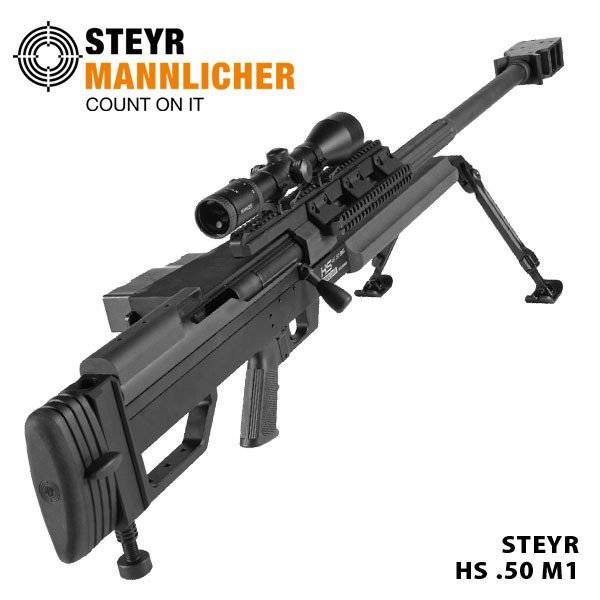
A few years after the presentation of the original HS .50, its modification was created under the name HS .50 M1. Its design has undergone significant changes. The main thing is an introduction to the design of a box-shaped detachable magazine for five rounds. The shutter remained almost the same. In addition, the Picatinny upper plank has become longer and, at the request of the customer, you can install strips on the edges of the box. There is almost no information regarding the supply of all HS .50 modifications. It is only known that Iran ordered 2006 or 700 of such rifles in 800 year. Whether the order was executed is already unknown.
12,7-mm sniper rifles are undoubtedly interesting, but they have already ceased to be a rare weapon. An account of their types has long been on the dozens. All the same Steyr at one time experimented with a larger caliber. In the 80 of the last century, Austrian gunsmiths created two interesting specimens. The first one was called AMR 5075 and was designed for an Austrian copy of the Soviet cartridge 14,5x114 mm, and the second - IWS 2000 - was intended for an experimental cartridge 15,2х169 mm. Consider the second. The name IWS 2000 is deciphered as follows: "Infantry Weapon System 2000" is an infantry weapon system of the year 2000. Apparently, Steyr was planning to start promoting his rifle to the market by the above mentioned date. The uniquely large caliber transparently hints that the IWS 2000 is not intended to defeat manpower, although the effect of falling into the human body will undoubtedly be quite remarkable. Since from the entire “spectrum” of objectives in this case only lightly armored equipment remained, it was necessary to create a new cartridge. The APFSDS 15,2-mm cartridge, like the rifle itself, is worth a separate story. The fact is that his bullet consists of a separating pallet and a tungsten feathered arrow. With an arrow body caliber in 5,5 mm and weight on the order of 30 grams, it can penetrate up to 40 mm steel homogeneous armor at a distance of a kilometer. If you need to fire unarmored equipment or manpower, then the effective range of the rifle combat increases to two kilometers. This is mainly achieved by a high initial speed of the bullet - about 1500 m / s.
It should be noted that the term “rifle” in relation to the IWS 2000 is not entirely correct, because its barrel has no rifling, and the stabilization of the arrow-bullet in flight is achieved due to its unwinding plumage. The large initial speed of the bullet and the large caliber required a relatively long barrel. On IWS 2000, it has a length of 1200 millimeters. Of course, in order to preserve at least some convenient dimensions, weapons had to be made according to the bullpup scheme. Also because of its originality, automation with a long barrel stroke is of some interest. Send the first cartridge from the box magazine (mounted on the right at an angle around 45 °) manually. After a shot, the barrel with the bolt rolls back about 20 centimeters back. Then the shutter turns and unlocks. He himself remains in the rear position, and the barrel goes forward, throwing out the cartridge case on the way. When the barrel returns to the forward position, the automatic releases the bolt. Moving forward, he will deliver the next cartridge and lock the bolt. After pressing the trigger, the cycle repeats. Such a seemingly complex system was used to “stretch” the returns for a while. Thanks to this, the shooter feels a noticeably smaller impulse than without such a system. Also, the reduction of recoil is achieved with the help of a developed muzzle brake and a hydropneumatic recoil device. As a result, when shooting from the IWS 2000, the arrow "kicks" no more than when using other large-caliber rifles. Sniper weapons weighing about 18 kilogram for convenience has a bipedal folding bipod. For carrying, the IWS 2000 is disassembled into two packs, which allows it to be transported by calculation forces.
Unfortunately for some military people and, fortunately for others, the “rifle” IWS 2000 remained an experimental and showpiece. Currently, Steyr continues to work on its improvement, reducing returns, expanding the range of ammunition, etc.
Artisanal separatists
At the beginning of the article it was said that the creation of sniper weapons is only possible in developed countries. But there are exceptions, and very interesting ones. At the beginning of the 90-x, when it was about to expect the separation of Chechnya from Russia, the local separatists mastered the production of large-caliber sniper rifles of their own design. At the surviving Chechen enterprises in almost artisanal conditions, rifles of the Al-Battar family (translated from the Arabic “Sword of the Prophet”) were made on the basis of serial samples.
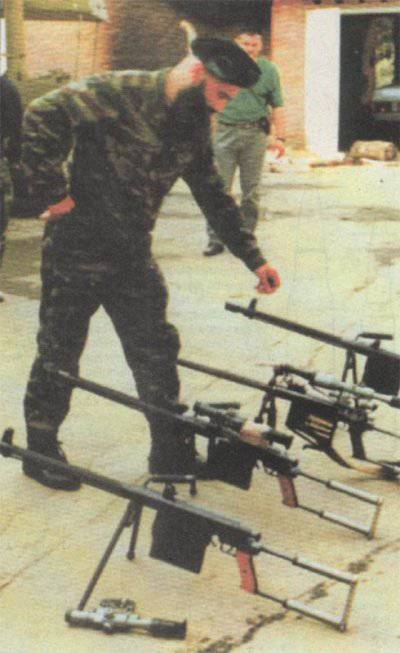 In the hands of the Russian military as a trophy fell rifles of two options - Al-Battar and Al-Battar II. They differ from each other in caliber (12,7 and 14,5 mm, respectively) and other things associated with it. Both rifles had a similar design with a sliding bolt. Even the bipod attached at the same place - at the front of the receiver. In turn, the first and second rifle ammunition of the family differed. Al-Battar was “packaged” with a five-round box magazine, and Al-Battar II was manually charged with one cartridge. On trophy samples there were no optical sights. Most likely, this was due to the forced "nature" of rifles. The open sight of both Al-Battar had only two positions, 500 and 1000 meters, which is clearly not enough for professional sniping, but enough for sabotage attacks. However, the poor quality of sighting devices can more than be compensated by the caliber of the weapon. With the manufacture of the most important and difficult part of the sniper rifle - the barrel - the Chechen gunsmiths did not play. These parts are simply removed from the machine guns DShK (millimeter 12,7) and CPV (mm 14,5). There is information that in the manufacture of Al-Battar rifles, weapons were used that were removed from the wounded armored vehicles of the federal forces.
In the hands of the Russian military as a trophy fell rifles of two options - Al-Battar and Al-Battar II. They differ from each other in caliber (12,7 and 14,5 mm, respectively) and other things associated with it. Both rifles had a similar design with a sliding bolt. Even the bipod attached at the same place - at the front of the receiver. In turn, the first and second rifle ammunition of the family differed. Al-Battar was “packaged” with a five-round box magazine, and Al-Battar II was manually charged with one cartridge. On trophy samples there were no optical sights. Most likely, this was due to the forced "nature" of rifles. The open sight of both Al-Battar had only two positions, 500 and 1000 meters, which is clearly not enough for professional sniping, but enough for sabotage attacks. However, the poor quality of sighting devices can more than be compensated by the caliber of the weapon. With the manufacture of the most important and difficult part of the sniper rifle - the barrel - the Chechen gunsmiths did not play. These parts are simply removed from the machine guns DShK (millimeter 12,7) and CPV (mm 14,5). There is information that in the manufacture of Al-Battar rifles, weapons were used that were removed from the wounded armored vehicles of the federal forces.As is clear from the ammunition used (12,7x108 mm and 14,5x114 mm cartridges), the recoil of both Chechen large-caliber rifles is very, very significant. The relatively small mass of weapons (14-16 kilogram) only enhances this effect. Even the muzzle brake, which was installed on both types of weapons, did not really help. According to military journalists R. Chumak and S. Kolomiyts, after a shot from Al-Battar II, “for two minutes you forget how to breathe, and for another two weeks you take a huge bruise off your shoulder.” Also an interesting fact about the "Al-Battar" lead fighters of one of the Russian units. During the storming of the village of Komsomolskoye in March 2000, a federal sniper destroyed a Chechen sniper armed with a large-caliber rifle. When inspecting the position of the latter, two bodies of militants were immediately found lying one on another. As it turned out from the prisoners, the 14,5-mm rifle has such a strong return that it alone cannot cope with it. Therefore, the fighter-sniper folded his padded jacket several times, laid it between the rifle butt and his shoulder, and then another fighter lay on top of it. This is the only way to compensate for the terrible returns of a handicraft weapon. Interestingly, the SOBR sniper eliminated the entire “calculation” of that rifle from Komsomolsk with a single bullet. It seems that the payment for compensation of return was too high.
…other
Of course, not all samples of large-caliber sniper weapons were described in this article. And 12,7, 14,5 or even 15,2 millimeters do not pull on an absolute record. As for the records, the most "cool" at the moment systems of small arms are 30-mm "rifles" Maadi Griffin 30 mm (cartridge 30х173 mm) and Russian SP-30 (cartridge 30х165). However, in any handbook on the subject of small arms it is clearly and clearly stated that small arms have a caliber of up to 20 millimeters, and all that is greater is artillery. So IWS 2000 can rightfully be called a record holder among small arms.
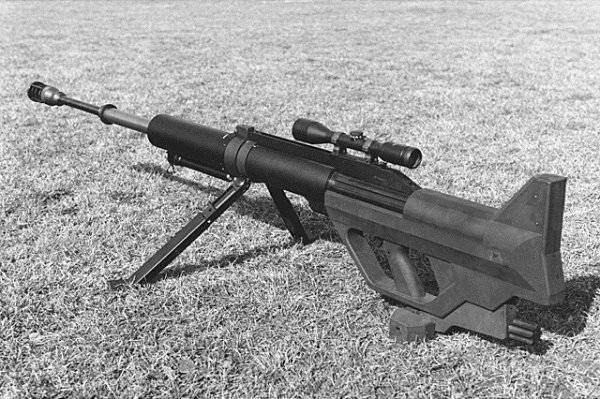
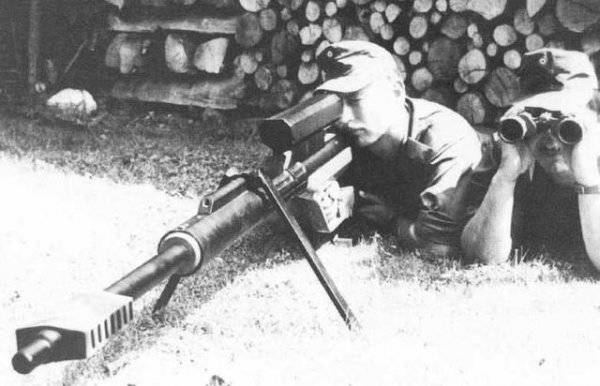
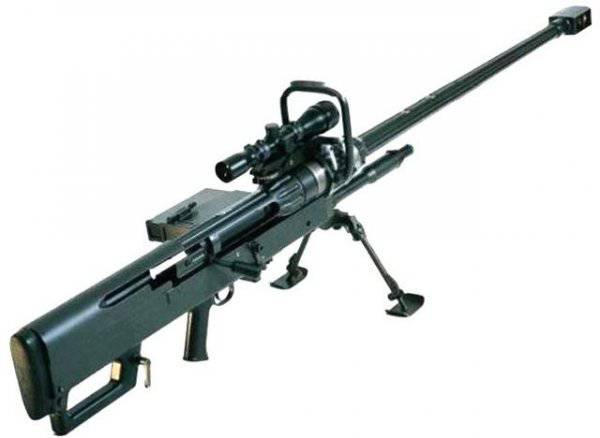
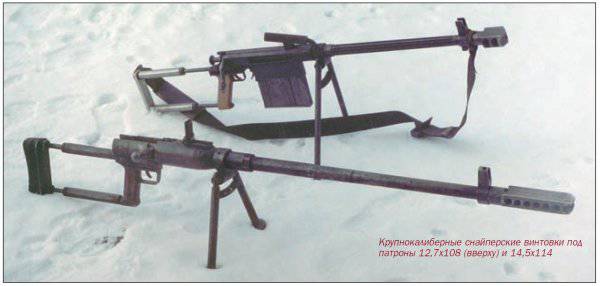
Information